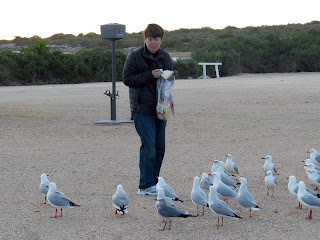In fact I saw another seven lifers on Christmas Island in December 2016, bringing my life total to an incredible 799! I did see Grey Wagtails (five birds, I think) but, although I heard it again, I could not see a Savannah Nightjar. However, I did see a Grey Nightjar, which is perhaps rarer. I walked through much dense undergrowth, hoping for Watercock, or indeed Swinhoe's Snipe, which I also wanted to see, but I didn't flush a thing.
 |
| Grey Wagtail - at last! Photo by James Mustafa |
The seven lifers I saw were (in the order I saw them):
Asian House Martins (793)
Grey Wagtail (794) (at last!)
Common Swift (795) (a first for the Australian list)
Grey Nightjar (796)
Japanese Sparrowhawk (797)
Malayan Night-Heron (798) and
Corn Crake (799).
 |
| Malayan Night-Heron, photo by James Mustafa |
How lucky was that! The Japanese Sparrowhawks were tiny. They were so small that I was surprised that they can ever be confused with Chinese Sparrowhawks. We also saw the local race of Striated Heron (amurensis) and Peregrine Falcon (calidus). Of course we saw all the endemics. The Island Thrush and Christmas Imperial-Pigeon were very common (as were kestrels) and we saw white-eyes and frigatebirds every day.
 |
| Island Thrush |
Every lunchtime I spent examining tropicbirds. Most were Golden Bosunbirds, some were White-tailed Tropicbirds and a few were Red-tailed. I was looking for a Red-billed Tropicbird. It really was needle in a haystack stuff. Scores of tropicbirds wheeled overhead. I searched the sky. The birds were often very high, and were often attacked by frigatebirds that were waiting for them returning from their morning feeding out at sea. I would never be able to discern a red bill. I was looking for a dark back. Alas! All the tropicbirds I saw had pure white backs. Richard had planned a boat trip around the island, which I thought would give me another chance of seeing the Red-billed Tropicbird. Unfortunately, seas were rough and the boat trip was cancelled.
The red crabs were migrating, but numbers were not as spectacular as I've seen on previous trips. We had quite a bit of rain, and got wet through on several occasions. Food was ordinary (apart from meals provided by Lisa, which were excellent, and a couple of dinners at the Chinese restaurant) as the island was running out of food. The Noodle Bar was closed. Seas were rough and the supply ship could not berth.
At dinner on the last night, everyone was asked to name the best bird of the trip. On these occasions, someone always says 'Golden Bosunbird.' They are, indeed, beautiful birds. But my bird of the trip (and I'm surprised that no one else named it) was the Corn Crake. HANZAB has only two reports of Corn Crake in Australia: one in Randwick, NSW in June 1893 and the other on board ship off Jurien Bay in WA in December 1944 (the previous port of call was Melbourne). So, while we saw birds that were not on the Australian list, the Corn Crake has been sitting stubbornly on the list, unseen for 72 years. I always enjoy adding a new bird to my list. But I seem to get more pleasure out of ticking birds that I never expected to see, birds that I cannot seek out, birds that haven't been seen for many years. Surely there is no better candidate than the Corn Crake.
 |
| Corn Crake, photo by Robert Shore |
Richard is to be congratulated for another extremely successful trip. He managed to ensure that almost everyone saw almost everything. Several people on the trip achieved milestones: most notably, Glen Pacey reached 800. Well done, Glen. Richard Baxter's tours of Cocos and Christmas Islands are now essential for any serious twitcher.
 |
| Caught in the act! Photo by James Mustafa |





































